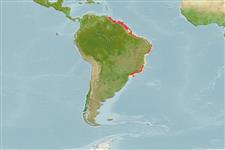Common names from other countries
>
Eupercaria/misc (Various families in series Eupercaria) >
Sciaenidae (Drums or croakers)
Etymology: Isopisthus: Greek, isos = equal + Greek, opisthe = behind (Ref. 45335).
More on author: Cuvier.
Environment: milieu / climate zone / depth range / distribution range
Ecología
marino; salobre demersal; rango de profundidad 1 - 45 m (Ref. 3702). Tropical; 10°N - 27°S, 83°W - 34°W
Western Atlantic: Costa Rica to southern Brazil.
Length at first maturity / Tamaño / Peso / Age
Maturity: Lm 15.9 range ? - ? cm
Max length : 41.5 cm TL macho / no sexado; (Ref. 122735); common length : 20.0 cm TL macho / no sexado; (Ref. 3702); peso máximo publicado: 740.00 g (Ref. 122735)
Espinas dorsales (total): 8 - 9; Radios blandos dorsales (total): 19-20; Espinas anales 2; Radios blandos anales: 18 - 19. Silver grey, darker above. A diffuse black spot at pectoral-fin bases, fins pale to yellowish. Mouth large, strongly oblique, lower jaw projecting. Upper jaw with a pair of large canine-like teeth at tip. Chin without barbel or pores, lower margin of snout with 2 marginal pores. Two widely separated dorsal fins. Gas bladder with a pair of horn-like anterior appendages. Sagitta (large earstone) moderately thick and oval (Ref 51721).
Found in shallow coastal waters over sandy mud or soft mud bottoms (Ref. 3702). Feeds mainly on small shrimps (Ref. 3702). Important food fish.
Life cycle and mating behavior
Madurez | Reproducción | Puesta | Huevos | Fecundidad | Larva
Cervigón, F., 1993. Los peces marinos de Venezuela. Volume 2. Fundación Científica Los Roques, Caracas,Venezuela. 497 p. (Ref. 9626)
IUCN Red List Status (Ref. 130435)
CITES (Ref. 128078)
Not Evaluated
Threat to humans
Harmless
Human uses
Pesquerías: escaso valor comercial; carnada: usually
Más información
ReferenciasAcuiculturaPerfil de acuiculturaRazasGenéticaElectrophoresesheritabilidadEnfermedadesProcesamientoMass conversion
ColaboradoresImágenesStamps, Coins Misc.SonidosCiguateraVelocidadTipo de nataciónSuperficie branquialOtolitosCerebrosVisión
Herramientas
Special reports
Download XML
Fuentes de Internet
Estimates based on models
Preferred temperature (Ref.
115969): 24.8 - 27.9, mean 27.4 (based on 110 cells).
Phylogenetic diversity index (Ref.
82804): PD
50 = 0.7500 [Uniqueness, from 0.5 = low to 2.0 = high].
Bayesian length-weight: a=0.00794 (0.00727 - 0.00868), b=3.07 (3.05 - 3.09), in cm Total Length, based on LWR estimates for this species (Ref.
93245).
Nivel trófico (Ref.
69278): 4.0 ±0.4 se; based on diet studies.
Resiliencia (Ref.
120179): Medio, población duplicada en un tiempo mínimo de 1.4-4.4 años (Preliminary K or Fecundity.).
Fishing Vulnerability (Ref.
59153): Low to moderate vulnerability (32 of 100).
